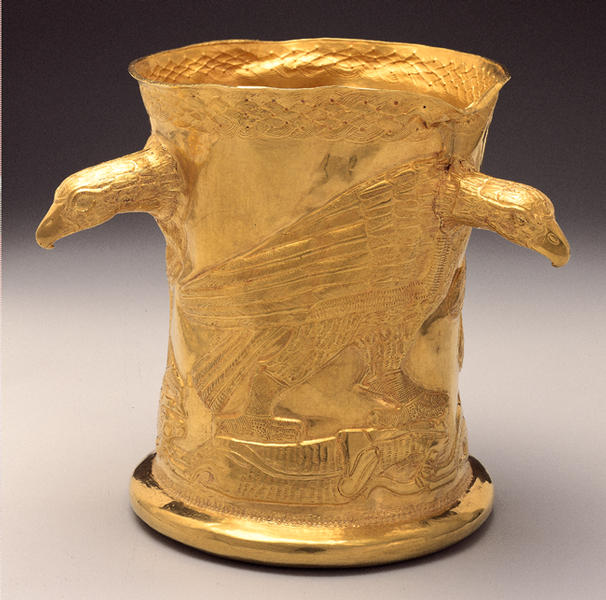Cup with Vultures and Gazelles
- Northwestern Iran
- 12th - 11th century B.C.
- Gold
- H-13.7 D-12
Catalogue Entry
This large, flat-bottomed cup has a narrow ridge around the base and slightly concave sides that are dramatically interrupted by the heads of three large raptors, or birds of prey. Each bird, moving to the viewer's right, treads on the supine body of a dorcas gazelle. The birds' small heads, with hooded eyes, and their long, slender necks, protrude abruptly at right angles, suggesting vultures rather than eagles. The three-dimensional extension of the heads and necks, combined with the sharp lines of the wings, tails, and legs, creates the illusion of movement-an almost hostile turning toward the spectator. These striking heads were made separately from the body of the vessel to which each was fastened with two small gold rivets, one at the top of the neck and the other at the bottom. Only after the heads were attached were the feathers worked on the surface, virtually obliterating the join between the two pieces. Their compact forms and smooth, scale-like feathers give a reptilian appearance to the birds' heads that would have been enhanced by the inlays in the eyes, which now are missing. The flat bottom bears a pattern of small interlocking six-petaled rosettes within a large, inscribed circle. Small punched circlets fill the petals of the rosettes and the spaces between the rosettes and the inscribed circular border. Each rosette has a small dot made with a ball punch marking its center as well as additional tiny petals budding between the longer ones.
The closest parallel to this cup in material, proportions, and method of attaching the heads is a gold cup with striding lions,1 excavated at Kalar Dasht north of Tehran, near the Caspian Sea, although the Kalar Dasht, cup is far cruder in the manner in which the lions' heads are joined to the vessel. Images of vultures and their prey appear on a tall gold cup from Marlik on which, among other images, three pairs of vultures tear at dead gazelles.2 The Marlik raptors, however, are arranged symmetrically, are worked in low relief, and focus only on the gazelles, with none of the outward motion of the Shumei birds. A small silver fragment, of uncertain provenance, bears an abbreviated version of the same scene.3 Nevertheless the sculptural effect of the cup with vultures, as well as details of style, composition, and execution, set it apart from these less dynamic versions. Rather than being a subsidiary motif, the vulture is the main subject-an image of power and dominance, whose broader cultural significance still eludes us.
TSK
1. See Metropolitan Museum 1996, p. 32, fig. 1.
2. See ibid., p. 33, fig. 2.
3. See Porada 1972, pp. 164-65, 173-75.
